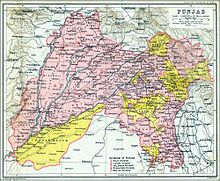Punjab Province (British India)
The Cis-Sutlej states, including Kaithal, Patiala, Jind, Thanesar, Maler Kotla, and Faridkot, were under the suzerainty of the Scindhia dynasty of the Maratha Empire, following the Second Anglo-Maratha War of 1803-1805, when Marathas lost this territory to the British. During the war, some of the states in the region gave their allegiance to British General Gerard Lake. At the conclusion of the Second Anglo-Maratha War, an 1809 agreement with Ranjit Singh, ruler of the Sikh Empire west of the Sutlej, brought these states under formal British protection.
Ranjit Singh's death in the summer of 1839 brought political chaos, and the subsequent battles of succession and the bloody infighting between the factions at court weakened the state. By 1845 the British had moved 32,000 troops to the Sutlej frontier to secure their northernmost possessions against the succession struggles in the Punjab. In late 1845, British and Sikh troops engaged near Firozpur, beginning the First Anglo-Sikh War. The war ended the following year, and the territory between the Sutlej and the Beas was ceded toBritish Company rule in India, along with Kashmir, which was sold to Gulab Singh of Jammu, who ruled Kashmir as a British vassal.
As a condition of the peace treaty, some British troops, along with a resident political agent and other officials, were left in the Punjab to oversee the regency of Maharaja Dhalip Singh, a minor. The Sikh army was reduced greatly in size. In 1848, out-of-work Sikh troops inMultan revolted, and a British official was killed. Within a few months, the unrest had spread throughout the Punjab, and British troops once again invaded. The British prevailed in the Second Anglo-Sikh War, and under the Treaty of Lahore in 1849, the Punjab was annexed by the British East India Company, and Dhalip Singh was pensioned off. The Punjab became a province of British India, although a number of small states, most notably Patiala, Kapurthala, Faridkot, Nabha, and Jind, retained local rulers in subsidiary alliances with the British, with the rulers retaining their own internal sovereignty but recognizing British suzerainty.
The Jallianwala Bagh Massacre of 1919 occurred in Amritsar. In 1930, the Indian National Congress proclaimed independence from Lahore. In March 1940, the all-India Muslim League passed the Lahore Resolution, demanding the creation of a separate state from Muslim majority areas in India. The ambiguity of the Lahore Resolution sparked violent protests, in which Punjab became a central stage.
In 1946, massive communal tensions and violence erupted between the Punjab's Muslim majority and the Hindu and Sikh minorities. The Muslim League attacked the government of Unionist Punjabi Muslims, Sikh Akalis and the Congress and led to its downfall. Unwilling to be cowed down, Sikhs and Hindus counter-attacked, and the resulting bloodshed left the province in great disorder. Both Congress and League leaders agreed to partition Punjab upon religious lines, a precursor to the wider partition of the country.

No comments:
Post a Comment